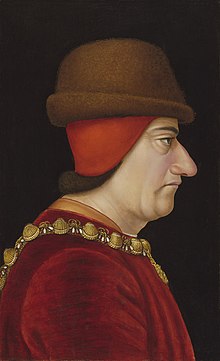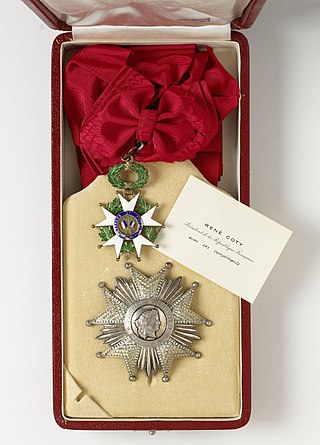
The National Order of the Legion of Honour, formerly the Royal Order of the Legion of Honour, is the highest French order of merit, both military and civil. Established in 1802 by Napoleon Bonaparte, it has been retained by all later French governments and regimes.

Paul Dubois was a French sculptor and painter from Nogent-sur-Seine. His works were mainly sculptures and statues, and he was also a portrait painter.
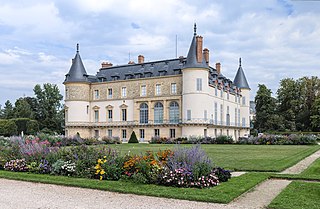
Rambouillet is a subprefecture of the Yvelines department in the Île-de-France region of France. It is located beyond the outskirts of Paris, 44.3 km (27.5 mi) southwest of its centre. In 2018, the commune had a population of 26,933.
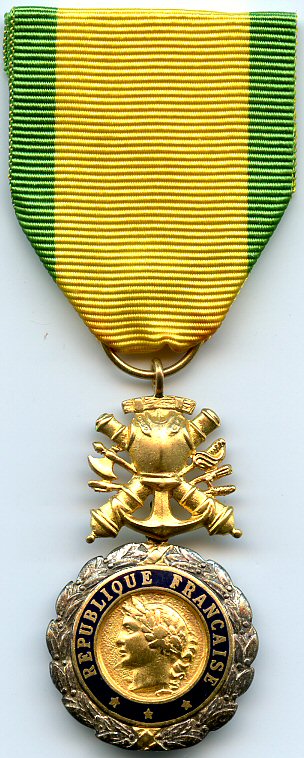
The Médaille militaire is a military decoration of the French Republic for other ranks for meritorious service and acts of bravery in action against an enemy force. It is the third highest award of the French Republic, after the Legion of Honour, a civil and military order, and the Order of Liberation, a Second World War-only order. The Médaille militaire is therefore the most senior entirely military active French decoration.

Dom Bernard de Montfaucon, O.S.B. was a French Benedictine monk of the Congregation of Saint Maur. He was an astute scholar who founded the discipline of palaeography, as well as being an editor of works of the Fathers of the Church. He is regarded as one of the founders of the modern discipline of archaeology.
The Ordre des Arts et des Lettres is an order of France established on 2 May 1957 by the Minister of Culture. Its supplementary status to the Ordre national du Mérite was confirmed by President Charles de Gaulle in 1963. Its purpose is the recognition of significant contributions to the arts, literature, or the propagation of these fields.

L'Aigle is a commune in the Orne department in Normandy in northwestern France. Before 1961, the commune was known as Laigle. According to Orderic Vitalis, the nest of an eagle was discovered during the construction of the castle.
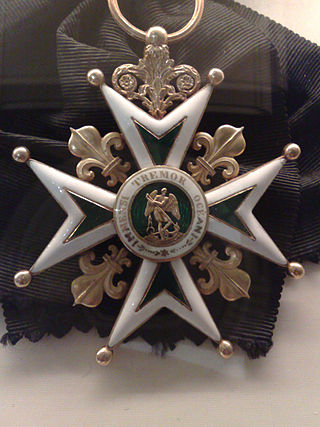
The Order of Saint Michael is a French dynastic order of chivalry, founded by King Louis XI of France on 1 August 1469, in response to the Order of the Golden Fleece founded by Philip the Good, Duke of Burgundy, Louis' chief competitor for the allegiance of the great houses of France, the dukes of Orléans, Berry, and Brittany. As a chivalric order, its goal was to confirm the loyalty of its knights to the king. Originally, there were a limited number of knights, at first thirty-one, then increased to thirty-six including the king. An office of Provost was established in 1476. The Order of St Michael was the highest Order in France until it was superseded by the Order of the Holy Spirit.

Guy-Victor Duperré was a French naval officer and Admiral of France.

An order of chivalry, order of knighthood, chivalric order, or equestrian order is an order of knights, typically founded during or inspired by the original Catholic military orders of the Crusades and paired with medieval concepts of ideals of chivalry.

The Order of the Holy Spirit, is a French order of chivalry founded by Henry III of France in 1578. Today, it is a dynastic order under the House of France.

A livery collar or chain of office is a collar or heavy chain, usually of gold, worn as insignia of office or a mark of fealty or other association in Europe from the Middle Ages onwards.
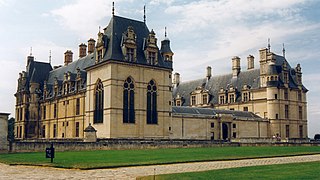
The Château d'Écouen is an historic château in the commune of Écouen, some 20 km north of Paris, France, and a notable example of French Renaissance architecture. Since 1975, it has housed the collections of the Musée national de la Renaissance.
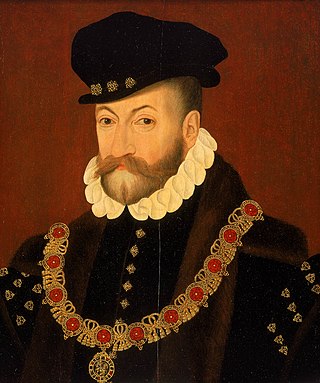
A collar, also known as collar of an order, is an ornate chain, often made of gold and enamel, and set with precious stones, which is worn about the neck as a symbol of membership in various chivalric orders. It is a particular form of the livery collar, the grandest form of the widespread phenomenon of livery in the Middle Ages and Early Modern Period. Orders which have several grades often reserve the collar for the highest grade. The links of the chain are usually composed of symbols of the order, and the badge of the order normally hangs down in front. Sometimes the badge is referred to by what is depicted on it; for instance, the badge that hangs from the chain of the Order of the Garter is referred to as "the George".

Louis-Messidor-Lebon Petitot was a French sculptor, who was born and died in Paris. He was the pupil and son-in-law of the sculptor Pierre Cartellier.
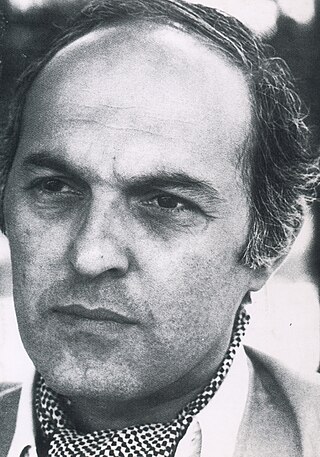
Goudji is a French sculptor and goldsmith of Georgian origin who was born in Soviet Georgia.

The Musée national de la Légion d'honneur et des ordres de chevalerie is a French national museum of orders of merit and orders of chivalry. It is located in the Palais de la Légion d'Honneur beside the Musée d'Orsay at 2, rue de la Légion-d'Honneur, in the 7th arrondissement of Paris, France. It is open daily except Monday and Tuesday; admission is free. The nearest métro and RER stations are Musée d'Orsay, Solférino, and Assemblée Nationale.
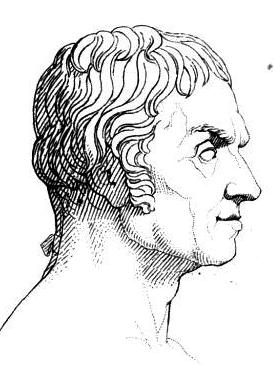
Jean-Guillaume Moitte was a French sculptor.

Hervé Pinoteau, 6th Baron Pinoteau was a French historian, expert in heraldic research and royalist apologist. He was the author of more than 900 articles and 22 books primarily on history and heraldry.
Originally part of the French Crown Jewels, sometimes considered its oldest part, and dating from the 7th century, the scepter of Dagobert was stored in the treasure of the Basilica of Saint-Denis until 1795, when it disappeared, stolen in the basilica and never seen again.

